Katana, if you haven’t heard, has received her own series, and given a chance to spread her wings and the main focus of a narrative, it’s interesting to see whether her character can handle that kind of scrutiny. That requires a certain depth of personality, motivation, and a world to move in that will at least partly separate her from team member roles, which she’s been associated with in the past. She’s done well as a supporting character, but this, really is a legitimate shot at the big time for her as a narrative lead. The fact that Ann Nocenti took on writer’s duties and the first two issues were drawn by Alex Sanchez suggests that DC really do want to give Katana a chance to shine and expand into a superheroine role. To do that she needs not only core qualities to make her a well-rounded superhero, but also writing that’s more than strong, since to many she’s still an unknown character, and artwork that can present a heroine in such a powerful role in a continually appealing way.
Though the series is part of the New 52, in many respects it has a strong genre comic feel, due to its martial arts focus and samurai tale of revenge framework. You might even call it a Yakuza tale. For issue #1 and 2/3 of issue #2, the story, in fact, doesn’t really have to be contained in the DCU to make sense, though by issue #3 it’s clear that for wider plot points and significant developments in Katana’s life, the DCU setting does come in pretty useful and help to establish tensions between her personal revenge quest and more public responsibilities.
[Spoilers ahead for issues #1-3!]
For a character to maintain a title on their own, they have to be fascinating in their own right, though, regardless of how many super powered friends they may have waiting in the wings. That’s going to depend on how their origins are handled and re-established and how their personality is presented in the current incarnation, initially through the writing on the comic. Katana’s story is classic, even archetypal, the product of a love rivalry that comes back to bite, a struggle between two brothers where the jilted brother goes down the path of a gangster and eventually seeks revenge, quite literally destroying Tatsu’s happiness in gruesome ways. Though the death of her children in the same attack and fire that kills her husband is not alluded to in these first three issues, that may well come to bear on her actions. Her initial revenge focus centers on the death of her husband at the hand of his brother and the prime plot assumption, that she acquires a magical sword, the Soul-taker, which she believes to be possessed by the spirit of her husband.
It’s kinky, certainly, and Nocenti doesn’t shy away from this weird situation, even depicting Tatsu in bed with the sword and apologizing to it for being unfaithful to “it”, her husband, in her dreams. Nocenti also maintains the traditional ambiguity that earlier appearances of the character established by not clearly revealing whether Tatsu “hears” her husband’s replies from the haunted sword, or merely imagines it. The fact that she might be a little crazy forms an interesting tension with her unwavering belief in herself, and a fairly significant strain of humility on her part.
But the biggest selling factor in the writing around Tatsu is the fact that Nocenti chooses to employ internal monologue. It’s actually a stroke of genius in the context of a character who believes she’s constantly talking to her sword, though it’s never clear if she’s talking to herself, the sword, or the reader. The narrative mode of operation is stellar, establishing a “voice” for the character to connect to the reader, revealing her psychology in intimate detail, and earning her respect from the reader for her cleverness, her determination, and her use of strategy. The language that’s used for Katana to tell her own story, blow by blow, is remarkably efficient, evokes plenty of atmosphere and attitude, and has its own energy that truly drives the story onward. This internal monologue tells you several things about Katana that you need to know: firstly, she’s not perfect, nor does she think she is. At every turn she’s critiquing herself, aware of her limitations, but also aware of her potential if she’s determined enough, from learning new martial arts skills to honing those that are rusty.
Secondly, one of her key philosophical codas in life seems to be that everything must be useful to justify its existence. This almost amounts to a religious perspective. It’s a real tour de force for narrative when she explains that every aspect of her accoutrement, no matter how feminine it might seem, has an objective purpose, from her dagger-like earrings to her steel necklace. Her rose-hued Kimono helps cover her well-hidden sword strapped to her back as she walks around her new environment in Japantown, a post internment camp colony outside San Francisco. You could even read this as a kind of metaphor for how gender is handled in the comic. Everything about this heroine is useful and active, a very smart move when trying to establish a central figure, regardless of their gender. The dialogue, as well as the internal narrative in the comic, is witty, revealing, and harks back to Kung Fu film in appealing ways, especially in the trading of insults typical during martial arts fight scenes, reminding the reader that struggles are psychological as well as physical. Katana can dish it out herself, showing her own adeptness at the art of total combat.
One among many of the strong themes introduced by Nocenti that gives the story a sense of meaning is the notion of control. Katana is driven by her anger, and it erupts in violence, but to be a true martial artist, her anger cannot be in control. This is a very archetypal heroic struggle, one faced by heroes like Batman who also face vengeance issues. But with Katana, it’s taken to the next level due to the fact that her sword has the capability to take over in a dangerous fight, particularly when facing foes related to the death of her husband, and yet the sword takes its toll on her, burning her hands every time it becomes autonomous in this way. Her enemies in the sword and dagger clans are aware of the amoral aspects of the sword, and even warn her about it on several occasions, questioning her desire to wield it. It’s an excellent metaphor for the dangers of directionless rage and the dark ways it can change a person. The reader is rooting for Katana not to lose her idealism and single-mindedness, but the sword brings that into question. Can she really control it? And is something so magical and ancient really a good thing?
The artwork on issues #1 and 2, by Alex Sanchez is alluring and just as tightly controlled as the narrative and dialogue in the comic. His choice of angles continually disorients expectation and surprises the reader, and there’s something not quite mainstream about his use of detailed lines, particularly when paired with the unusual color motifs by Matt Yackey that give the reader a sense of the unfamiliar. The use of rose, red, and black establishes a kind of color code for Katana, and she’s frequently depicted in lavender or rose herself, not your average superheroine color. It may be an allusion to the color of the Sakura flower, or even a suggestion of art traditions in Japan, but whatever the reason for the choice, its very effective at establishing the personality of the comic in interesting ways. Sanchez is also unafraid of portraying lines and grooves in a photorealistic manner, particularly when presenting faces, and this adds to a sense of realism and physicality in the comic not all that typical of superhero books, an excellent idiosyncratic feature. He handles combat scenes with multiple figures with aplomb, never breaking down reading logic in his panels. Lastly, Sanchez does not downplay the amount of armor and weaponry that Katana has to tote around. It would be tempting for him, no doubt, to stream-line her figure rather than draw each joint and plate of her costume in multiple poses, but there’s an added realism in his determination to make her combats, gear and all, as believable as visually possible.
Cliff Richards takes over as penciller in issue #3, and though his style is quite different, and he is joined by colorist Pete Pentazis, the changes in the visual style of the comic have their own strengths. #3 presents Katana, initially in disguise as a waitress, in a more stylish mode, which plays into the themes of the issue. While #1 and 2 tell us of Katana’s past, #3 jumps more fully into the present day and there’s a modern, upbeat feel to the line work and her informal lessons with her drunken fighting master Junko. In several panels and striking spreads, Richards makes the choice to present Katana as a figure in several places at once, showing her movements through a fight scene, which bring a lot of energy to the narrative flow. Here Katana moves from a hero with a magical sword to more established superhero mode, but hasn’t lost her character along the way.
Nocenti’s ongoing internal monologue helps keep continuity through these artistic shifts and the plot points in #3 are just as significant as in #1 and 2. In fact, the big climax of #3, which you’d be particularly clever to have seen coming, seems devastating, the destruction of the Soul-Taker sword by Killer Croc, and the apparent revelation that the spirit speaking to her in the sword was none other than the malevolent Creeper, whom she previously slew. This is a truly shocking scenario since the Soul-Taker is not only Katana’s sole claim to superhero powers, but also the key to her psychology. It’s an intrinsic page-turner making you wait impatiently for the next issue just to see how the creative team can possibly resolve this wholesale destruction of Katana’s character in one fell swoop. This is where the particular relevance of the DCU comes in, since it’s unlikely that a member of the sword or dagger clan could have destroyed a sword they, too, revere, and for someone to truly destroy Katana, they have to be part of a bigger superhero universe to do so. It also reminds of her past appearances and ties this new presentation of the character into tradition.
Though the almost medieval, and romantic, if dark, history of Katana told in issues #1 and 2 are enough to make her fascinating, Nocenti maintains this with her superb writing and the art teams provide solid visual appeal to keep you grounded in the world of the character. There are plenty of genre aspects for the genre lovers, plenty of psychology for those who hope for a nuanced character to get to know, and enough motivation for a lifetime, really, of heroic exploits in KATANA. The series has been launched with the strongest possible elements working in its favor, and it’s very likely that it can continue to give the character the spotlight she’s capable of maintaining, particularly now that readers have been reminded that even for Katana, there’s always something on the line, always something more to lose in the vengeance game.
Title: KATANA
Publisher: DC Comics
Issue #1 Creative Team:
Anne Nocenti, writer/Alex Sanchez, artist/Matt Yackey, colorist/Taylor Esposito, letterer
Issue #2 Creative Team:
Ann Nocenti, writer/Alex Sanchez, artist/Claude St. Aubin, inker/Matt Yackey, colorist/Taylor Esposito, letterer
Issue #3 Creative Team:
Ann Nocenti, writer/Cliff Richards, penciller/ Rebecca Buchman, Juan Castro, Le Beau Underwood, Phyllis Novin, inkers/Pete Pentazis, colorist/ Taylor Esposito, letterer
Hannah Means-Shannon writes and blogs about comics for TRIP CITY and Sequart.org and is currently working on books about Neil Gaiman and Alan Moore for Sequart. She is @hannahmenzies on Twitter and hannahmenziesblog on WordPress.


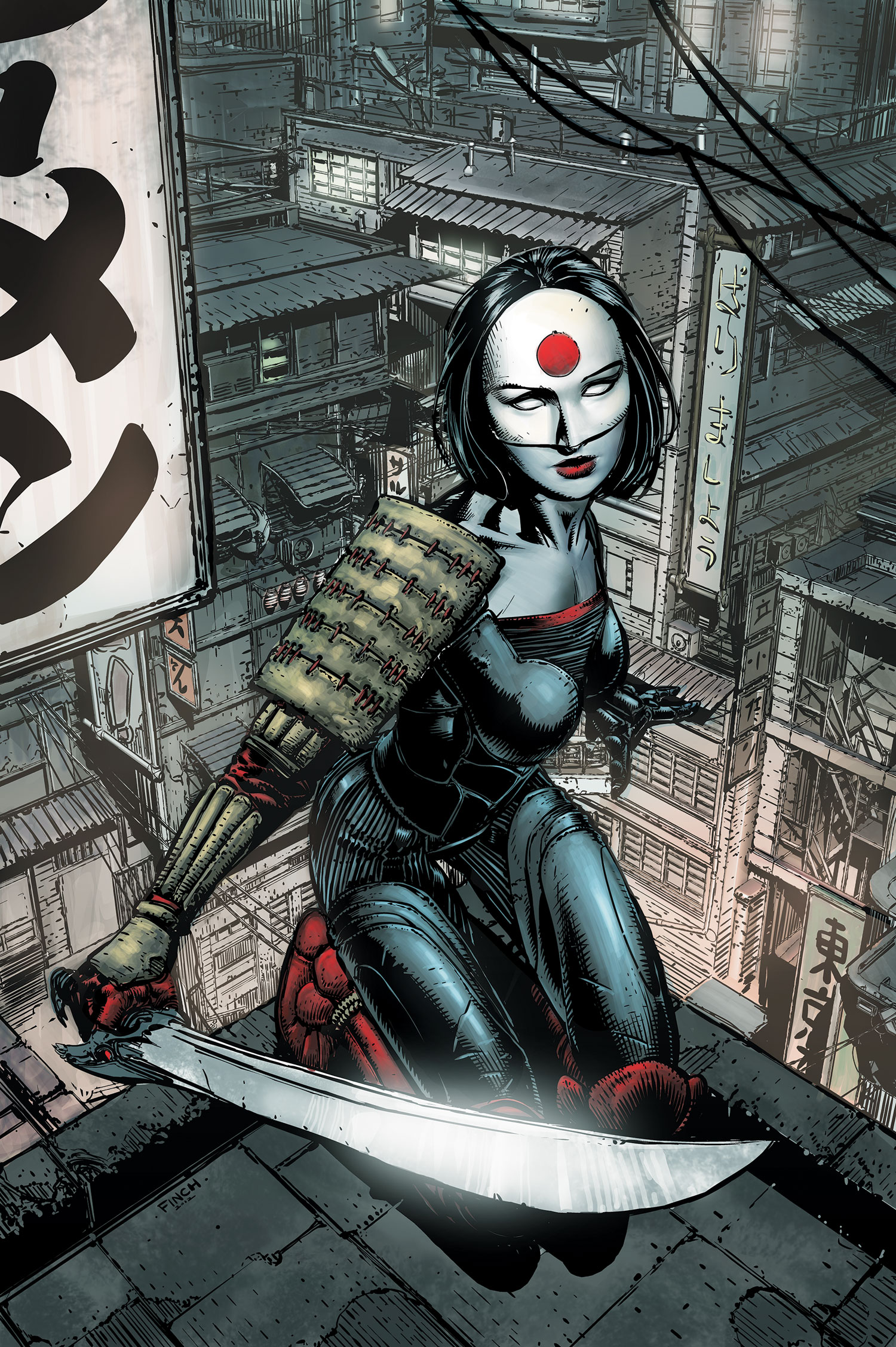
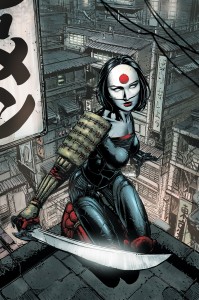
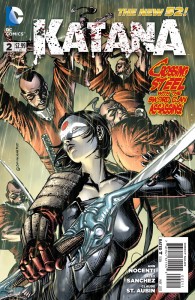
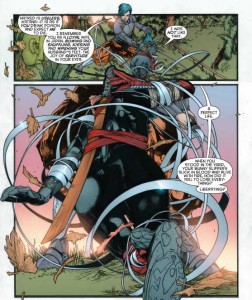
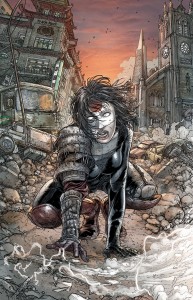
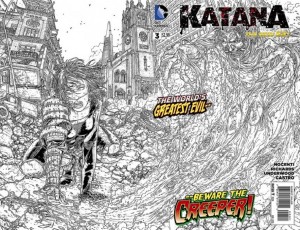





“For a character to maintain a title on their own, they have to be fascinating in their own right, though,”
Sort of – BEFORE that what was the hook in the advertising and marketing? I’m aware of the character because I am a long time reader but if you asked me what was said about the character that would make me pick up the series, I can’t remember… she has a sword and it has her dead husband in it but.. so what? what’s the hook?
I picked up the third issue for the Creeper’s appearance, but I wasn’t aware that Katana had killed him- in what book did this occur, or was this something that was freshly pulled out of it’s editorial ass? (The Creeper just happens to be one of my all time fav DC characters – owning all of Steve Ditko’s silver age appearances).
It was inevitable that DC would have to give Katana her own book – as she will be co-starring with Batman in the new CGI animated “Beware the Batman” series that’s premiering this summer. I mean, that’s the first thing that came to my mind when they first announced this title.
~
Coat
Really enjoyed what I have read so far.
Comments are closed.